The Diesel engine and its development
ENGINES are not being made on the single night........As an engineer we all should know about the history of engines...
1673 Christian Huygens, a Dutch scientist, produces the first known heat engine from his inspiration of a cannon. Mr. Huygens place a cannon vertically, and used a piston instead of a cannonball. The cannon had exhaust valves near the top and the piston was attached to a weight by means of rope and pulley. He calculated that a .5 kg of gunpowder could lift 1360 kg piston over nine meters. But the absence of a reliable fuel hampered its development.
1736 In England, a patent for a Newcomen engine-powered steamboat is issued to Jonathan Hulls. But until improvements are made to the steam engines, by James Watt In 1821, the concept is found to be not feasible.
1776 France's Marquis Claude de Jouffroy, and his colleagues, successfully sail the first steamship on the Doubs River. The 'Palmipède', a 13 metre long vessel, is powered by rotating paddles.
1787 In Virginia, USA, James Rumsey is granted a patent, one year after sailing the Potomac River in the first steam powered, pump-driven (water jet) boat.

1791 Englishman John Barber receives the first patent for a basic turbine engine. The turbine (pictured) was designed with a chain-driven, reciprocating type of compressor. It has a compressor, a combustion chamber, and a turbine.
1801 French chemist Philippe Lebon develops a usable coal gas. Shortly after he patents a coal gas fired internal combustion engine.
1802 The 'Charlotte Dundas' tows two 70-ton barges, 30 km, along the Forth and Clyde Canal to Glasgow. Not only was this vessel the first practical steamboat, but also the first tug boat.
1804 Richard Trevithick built the first, albeit crude, locomotive using a steam engine mounted on a wagon riding steel rails.
1807 The Malayan fire piston, originally from southeast Asia, is brought to Europe. It was a air pump type tube, when compressed would heat up the air and ignite a small clump of tinder.
1820 William Cecil, 28 year old Fellow of Madeleine College, Cambridge, is the first to build an engine to run continuously. It uses a mixture of hydrogen and air (1:3) but soon abandons it when he is ordained in the Anglican church.

1821 James Watt improves the efficiency of Newcomen’s reciprocating pump to become the most efficient (4%) prime mover using pistons and expanding steam. The engine become the most popular at the time and lasted for quite a while.
1824 Sadi Carnot published his theory on the thermodynamic cycle of the heat engine. From it, Rudolph Diesel would design his engine.
1825 'Curacao' built in Dover, England, becomes the first practical steamship to sail. It is bought by the Netherlands Navy. It is a wooden hull, 445 tonnes, paddle-wheeler with two engines developing 75 kW.
1827 Machinefabriek Werkspoor is founded, in Amsterdam.
1834 The Wartsila company begins operations, originally as a sawmill operation, in Tohmajärvi, Finland. Twenty years later it would later morph into an iron mill. Pictured, below - right, in 1880.

1829 George Stephenson builds the 'Rocket'. The first practical locomotive which made ten trips a day over a 2.4 km hauling a 13 tons at about 24 km/h for the Liverpool & Manchester Railway.
1854 Italian inventors, Eugenio Barsanti and Felice Matteucci, are granted a patent, in London, for the first working, efficient version of an internal combustion engine. Nicolaus August Otto, would, however, go on to claim the bulk of the credit for the four cycle design, ten years later.
1860 The first production engine is patented in Paris. Jean Joseph Etienne Lenoir builds around 500 of these 7:1 air gas ratio engine. But they were prone to problems, due to their electric ignition.

1864 Nicolaus August Otto and Eugen Langen form the N.A. Otto & Cie. In 1867 they premiere their first working model. At first, the one cylinder "coffee grinder" design, with it's horrible racket, scares away the Paris Exposition 1867 judges. But they realized it was the most efficient engine of the exposition, and the engine takes first prize.
1872 With many back orders for their successful engine, N.A. Otto & Cie. established a new plant. They called it Gasmotoren-Fabrik-Deutz, after the Deutz neighbourhood of Koln, Germany. They hire a production manager, Gottlieb Daimler and an assistant Wilhelm Maybach. These three men, some of the greatest engineers who ever lived, now worked under one roof. Shortly after, Otto "comes up" with the four strokes of an internal combustion engine; intake, compression, ignition/expansion, and exhaust were all assigned a "stroke"; similar to the patent issued to Italian inventors in 1854.
1876 Otto’s new design is built. The one cylinder, flame ignited prototype is "handed over" to Maybach who develops it for production. It becomes know as the "Deutz A"engine. With an efficiency of over 16% and quiet operation, it is issued a patent insuring it almost a virtual monopoly.
1878 Dugald Clerk, a Scot, is granted a patent which lays down the groundwork for the two stroke compression engine design. It is demonstrated at Kilburn, England in 1879.
1879 Karl Benz expands on Clerk’s ideas, and establishes Benz & Cie in Manheim to develop the engine idea. Deutz's stranglehold on Germany sees to it that a patent is not granted to Benz's ideas.
1880 The 137 meter, 5,247 tonnes 'Arizona' is the first steam powered vessel to win the mythical "Blue Ribband". The White Star Line steel hulled ship reached 32 km/h with her John Elder & Company ‘s 4,679 kW compound steam engines.
1882 Daimler quits Deutz because of some contentious issues over patents with Otto. Maybach join Daimler to research the possibility of a light weight, higher speed, internal combustion engine.
1886 Deutz stranglehold on the basic patent of the internal combustion engine is reversed. A patent attorney for Geruber Korting finds a prior patent, laying out the exact cycles of the internal combustion engine. The French transportation engineer,Alphonse Beau de Rochas, had filed it on January 16, 1862.
1886 Benz’s biggest problem, the magneto design, is remedied by Robert Bosch. The final prototype, the three wheeled 'Dogcart', is a success.
1889 Rudolph Diesel, with his French connections, is the only German engineer invited to give a his paper, "Revue Technique de l’Exposition Universelle" at the International Engineering Congress.
1889 Charles Parson founds, C. A. Parsons and Company in Newcastle, England, to produce turbo-generators to his design. The company's first turbine was only 1.6% efficient and generated a mere 7.5 kilowatts.
1890 Herbert Akroyd Stuart, born in Halifax, Canada in 1864, and Charles Richard Binney are granted patent # 7146, which described the world's first compression-ignition engine. Their submission is called "Improvements in Engines Operated by the Explosion of Mixtures of Combustible Vapour or Gas and Air".
1890 Herbert Akroyd Stuart's prototype engine is built at his father's Bletchley Iron & Tin Plate Works at Bletchley, England. The rights to build the new engine are then leased to Richard Hornsby & Sons of Grantham. They go on to build Hornsby engine #101 and #102 which are installed at the Great Brickhill Waterworks, at Fenny Stratford, in May 1892. 32,417 various copies of the type are subsequently sold.

1892 Rudolph Diesel draws his theories into a design, but it is decline a patent in Europe, at first. On appeal his "not original" idea is patented on February 28. Patent # 67027 is issued to Rudolph Diesel by the Imperial Patent Office in Germany. It was a design using much higher pressure to achieve Carnot’s ideal heat cycle. Sometime later, Diesel is granted a patent in the United States for the new engine.
1892 German Carl Pieper introduces the helix on plunger to fuel injection system, allowing control of the fuel quantity delivered to a cylinder.
1893 Benz’s engine the 'Standhur' (Upright clock) runs continuously at the Paris Expositions. The beginning of a long "work day" for it.
1893 Rudolph Diesel rewrites his manuscript "The theory and construction of a rational heat engine to replace steam engine and contemporary combustion engine" to "Eines rationellen Warmenmotor" describing his theory of a heat engine with an estimated 70-80% efficiency. He is severely criticized by his peers, the "leading edge" German engineers.

1893 In July, Rudolph Diesel, assistant Lucian Vogel, and his father in law, Heinrich Buz at the 'Ausgburb Machine Works'begin experimenting with Rudolph Diesel's new prime mover.
1894, February 17, Diesel's experimental engine runs at 88 rpm for about one minute, the first time ever, about 9 months after first "test firing". Click here to download the Shell Petroleumfilm "Diesel Story", featuring scenes from the 1942 film aboutDiesel and his engine (88 mb).
1894 Witte, Reid, and Fairbanks start building oil engines with a variety of ignition systems.
1895 William H. Scott is granted an English patent for a double port helix for fuel injection pump. This development allows to control both the beginning and ending of fuel injection.
1896 Work begins on the French submarine 'Narval', it is launched in 1899. It features a novel electric propulsion system using steam boiler as prime mover. The technology leads to the Diesel electric propulsion system of 'l'Aigrette' in 1904.
1897, February 17, the Diesel’s engine runs on its own. The water cooled, ringed piston, fuel injection, single cylinder engine ran on cheap kerosene. It was considered a total success. It produced 13.1 kW at 154 rpm, and achieved 26.2% efficiency.
1897 Mirrlees, Watson & Yaryman of Glasgow, among others, sign a deal to build the new prime mover from Rudolph Diesel.

1897 Immanuelle Lauster, at Machinenfabrik Augsburg, designs and build the first twin cylinder prototype Diesel engine. It develops 44 kW at 180 rpm, this is achieved by increasing the size of the bore and stroke as well as other refinements.
1897 Charles Parson's turbine-powered yacht, 'Turbinia', speeds past theRoyal Navy's fastest ships, at 34 knots, demonstrating its abilities during Queen Victoria's Diamond Jubilee Fleet Review. Two years later the Royal Navy launches new steam turbine powered warships, and thus began the start of the marine steam turbine era.
1898 June 10, Sulzer starts building it’s first Diesel engine A four stroke, 260mm cylinder, developing 14.7 kW.
1898 Burmeister & Wain (B&W) of Kohaven, Denmark retain rights to build the Diesel engine. As do Aldophus Busch (Budweiser beer in US) who sets up the Adolphus Busch’s Diesel Motor Company of America. Vickers Sons & Maxim Ltd of England andGebruder Howalt-Werf are among others. Sweden financiers Marcus Wallenberg andOscar Lamm set up AB Diesel Motorer. Emanuel Nobel, Swedish-Russian nephew ofAlfred Nobel, acquires the rights to build the Diesel engine and promptly establishes the Russian Diesel Company of Nuremberg.

1898 The first commercial Diesel engine is sold to Aktiengesellschaft Union, a matchmaking company in Kempten near Ausgburg, Germany. It is one of Lauster’s twin cylinder design. It is delivered in January and started up on March 5. After fifteen years it still ran perfectly, without any major repairs.
1898 After a successful exhibition of their engines, side by side, at the Munchen Power and Works Exhibit, Machinenfabrik Augsburg and Nurnberg decide to continue their partnership. The partnership’s name is shortened in 1904 to Machinefabrik Augsburg-Nurnberg, better known today as M.A.N.
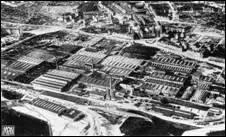
1898 In order to manage the explosive growth of the Diesel engine. Rudolph Diesel’s establishes a company to manage the licensing of the design. The new venture buys all patents and is tasked with the further developments and management of the new engine. It is called the General Diesel Corporation, and is founded on September 17.Rudolph Diesel is paid a sum of 3.5 million German marks.
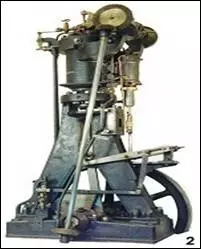
1900 Rudolph Diesel develops the first fuel injection valve. " It consisted of a mechanically operated valve surrounded by a stack of drilled discs, or pulveriser rings, on which the oil was deposited and then blown by compressed air into the engine cylinder during injection. " (History of the Fuel Injector by Frank DeLuca)
1900 The Diesel engine takes the "Grand Prix", the highest prize, at the 1900 Paris Exposition. The exhibition was attended by 50 million people. Promoted by the French Government and N.A. Otto & Cie (Deutz), the engine runs on peanut oil, now commonly known as biodiesel.

1902 Adolphus Busch’s company build the first Diesel engine in the United States. It is a three cylinder, 55 kW model, which first ran in April. Fewer than 100 were sold, most of them without profit. Download the 1914 sales brochure documenting this company's numerous installations that followed this milestone - pictured right.
1902 French submarine 'l’Aigrette' is launched with a MAN licensed Diesel engine and electric propulsion. It is believed to be the first vessel to be powered by a Dieselengine. It would go on to influence submarine design in the UK, US, Germany and France as well as commercial vessel such as 'Vandal' and 'Venoge' (see below).
1902 F. Rundlof invents the two stroke crankcase, scavenged hot bulb engine.
1903 Sulzer begins engine manufacturing in Winterthur, Switzerland. Three years later, they offer a range of 12 engines with power from 11 to 440 kW.
1903 Norwegian Aegidius Elling builds the first gas turbine, producing excess power. The turbine uses both a rotary compressor and turbine.
1904 KW Hagelin, engineer in charge of Nobel’s marine division, oversees the building of 'Vandal'. A 74.5 meter long, shallow draft tanker with a cargo capacity of 800 tonnes. A revolutionary design at the time. Three 500 VDC generators driven by 3 cylinder AB Diesels, supplied 88 kW each, at 240 rpm. These generators supplied power to 75 kW reversible DC motors. A setup almost identical to today’s locomotives.
1904 Ancient Etablissment Sautter-Harle of Paris, licensed by Diesel in 1899, builds the first opposed piston, reversing engine. The four stroke, two cylinder, 16.6 liter engine develops 19 kW and was installed in the 38 meter Canal Ship 'Petit Pierre',which also boasted a variable pitch propeller. The firm’s next engines, larger versions of the previous design, were delivered to the French navy for installation into their submarines.

1904 M.A.N. installs four DM4x100 diesel engines, with a total power of 1193 kW turning at 160 rpm, for the Kiev Municipal Transport Authority, the first power plant of its
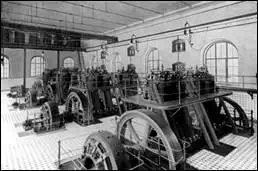
kind. At the time the engines cost 854,000 German marks and remained in operation until 1955.
1904 Sulzer installed their first diesel engine in a ship, the freight boat 'Venoge'. It was much like the'Vandal', but Sulzer was dissatisfied with the electric motor, the only way to get reverse. They go on to develop their two stroke, reversing engine. One year later...
1905 The first two stroke, and the first direct reversible engine (as opposed to starting in reverse) is built by Sulzer. It had four cylinders with a bore of 175 mm and stroke of 250 mm producing 66 kW. It is on exhibit at the Milano World Exposition in 1906.
1907 Rudolph Diesel’'s patent in Europe expires. A flood of new engine building begins.
1907 Nobel Brothers builds the first four stroke reversible engine.
1908 350 dwt cargo ships 'Rapp' and 'Schnapp', coastal schooner by design have Swedish A.B. Motorer engine installed as auxiliary propulsive power. The 89 kW, 300 rpm reversible engines are the first commercial sea-going application of diesel engines.
1909 In 1907, Benz & Cie entices a young Lebanese engineer, Prosper L’Orange, from Deutz. He goes on to design the pre-combustion chamber. Making the Diesel engine run smoother and quieter, but with a slight loss of fuel economy.
1910 James McKechnie of Vickers in England, develops the first solid injection fuel system. The design is still very much in use to day and comprises of a metering pump, operated by the cam lobe, delivering fuel oil which was then injected into the engine cylinder by a fuel valve.
1910 The 'Fram' receives it's 132kW engines from AB Diesel Motorer of Sickla, Sweden. The ship carries Roald Amundsen to the Antarctic. He becomes the first man to reach the South Pole on December 14, 1911. AB goes on to adopt the Polar trademark.
1911 Sulzer builds a larger version of their 1905 engine, ushering in the age of the large slow speed two stroke engine; quite a bit larger. The one cylinder, with a meter diameter piston turns at a leisure pace of 150 rpm. It produces an astounding 1472 kW. Shortly after, they begin
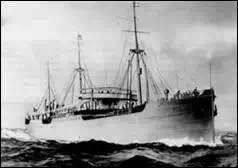
building a four cylinder version to produce 2760 kW.
1911 A British patent is issued to Frederick Lamplough for a unit fuel injector. The idea was first floated by Carl Weidman of Germany in 1905. The unit injector does away with troublesome tubing from the pressure pump to the fuel injector. A Winton engine would feature the new style injection system, but not until 1931; in 1934, GM would adopt the unit injector for its two stroke high speed diesels.
1912 February 14, Burmeister & Wain builds the first ocean-going motor ship, the 7,000 DWT 'Selandia', for the Danish East Asiatic Company. It starts a revolution in shipping and ship design by being the first ocean going motor ship. It is launched on November 4, 1911, and has two B&W DM8150X, four stroke, reversible engines developing 932 kW each at 140 rpm. The ship design ushers in a new era; one without a traditional funnel, casting away the old steam ship funnels or sails of the past.
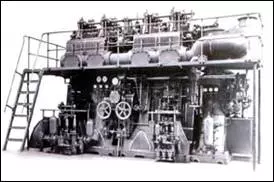
1912 Hamburg Sud cargo liner, the 'Monte Penedo', launched several days before the'Selandia' was completed, is the first ship to be powered by two stroke engines. The two Sulzer engines developed a combined 1250 kW at 160 rpm, one of them is pictured on the left.
1912 The first Diesel locomotive
is built. The 80 tonne locomotive is built by Sulzer, Krupp, an
the Prussian & Saxon State Railway. The first revenue earning
locomotive is built byASEA for Sweden’s Melersta Sodermanslands
Railway in 1913.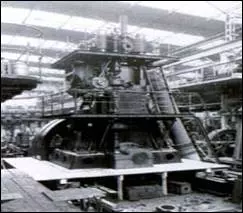
1912 The Diesel patent expires in the US. New companies spring up to build their versions of the engine. Allis-Chalmers and Nordberg in Milwaukee, Fairbanks-Morse in Beloit and Worthington Cudahy - all in Wisconsin, heart of the dairy states, a popular place for German immigrants. As well Busch-Sulzer set up shop in St Louis, and Winton in Cleveland.
1912 Sulzer tinkers with their 1S100, an experimental engine. It has a bore of 1 meter and holds the title, engine with the largest bore, for almost 60 years.
1912 Otto F. Persson of the United States patents the tight fitting plunger and barrel design for high pressure fuel pump, elimination the packing glands used to seal high pressure fuel injection pumps.
1913 Hugo Junkers, an aeronautical engineer, builds a four cylinder lightweight Diesel engine for an aircraft. Shortly after, a six cylinder was producing 368 kW at 2400 rpm.

A worker poses for this picture, from the MAN factory, in Nurnberg, Germany, taken in 1913
1913 Vickers, Ltd. develops the common rail system. " A multi-plunger pump delivered fuel to an accumulator and header of large capacity with the fuel pressure maintained at about 5000 psi by a relief valve, and the fuel was sprayed into the engine cylinders through mechanically operated injection nozzles. Fuel metering was controlled by varying the period of opening of the injection valves." (History of the Fuel Injector by Frank DeLuca)
1914 Sulzer develops piston cooling and scavenging for their two stroke engine.
1914 Francois Feyens of Belgium introduces the rotary distributor injection system, to deliver metered fuel to the several cylinders of a multi-cylinder engine. The system would be installed on the 'Selandia' on its first voyage to the far east.
1914 The Diesel powered German U-boat, U-9, meets and sinks the British cruisers Aboukir, Cressey, and Hogue off the Dutch coast in less than one hour. The Dieselpowered submarine could no longer be ignored.
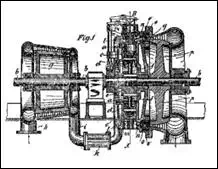
1915 Swiss engineer Dr. Alfred J. Büchi, Chief Engineer of Sulzer Brothers Research Department, proposes the first prototype of a turbocharged diesel engine. He had been working on the design since 1909. Even with a 40% increase in an engine's efficiency, his idea was not well received.
1916 Hugo Junkers unveils the Jumo, a six cylinder opposed piston aircraft engine. It is installed in the Dornier Do18 flying boat. The Deutsche Lufthansa Do18 break the long distance flight record to Caravellas, Brasil from the English Channel.
1919 In 1909, Jonas Hesselman of AB Diesel Motorer and Harry Leissner at Lujussne-Woxna were working on a solid fuel injection system. It is not until 1919 that Prosper L’Orange brings it all together. He successfully incorporates fuel injection in Benz’s one cylinder, giving us a smooth running engine.
1919 Clessie L Cummins begins operations in the United States, backed by investment banker William Glanton Irwin. He purchases manufacturing rights to the Diesel engine from the Dutch licensor Hvid.
1919 Sir Harry Ricardo pioneers the swirl chamber, a slightly different combustion chamber than Mr. L’Orange ‘s design.
1919 Atlas Imperial Diesel Company of Oakland, California builds the first American Diesel engine with common rail injection system.
1920 Enterprise, in the US, builds its first engine, it later becomes a division of DeLaval. Atlas-Imperial of Oakland, Union, and Lister are other companies start appearing in the 1920's, building Diesels engine.
1920 William Oxford & Sons, at the time the second largest yard in Great Britain, abandons building ships with steam propulsion, in favour of Diesel engine powered ships.
1922 Benz & Cie’s stationary engine division becomes it’s own company. It becomes the Motoren-Werke Manhein AG better known as MWM.
1922 the Robert Bosch Company of Stuttgart, Germany, focuses its business activities to specialized in the design and manufacturing of fuel injection equipment. In 1927, they introduce a jerk pump, with helix control, for which Ottmar Bauer is granted a patent in 1931. Up to now, Diesel engine builders were mostly manufacturing their own fuel injection systems, to varying success.
1922 Electro-Motive Engineering Company, the genesis of the "Steam Dragon Slayer",EMD, is founded by Harold L. Hamilton and Paul Turner in Cleveland, Ohio.
1923 General Electric, American Locomotive and Ingersoll Rand collaborate to produce a Diesel powered switcher engine. It works around the clock at New York Central’s yard, operating for only ten cents per kilometre. A refined model becomes the first commercially produce units, they are bought by the Jersey Central Railroad Remaining in service at the Bronx yard for 30 years.
1923 Peugeot installs the first Diesel engine in their car.
1924 Benz & Cie introduces their transport truck, the 5K3. M.A.N. introduces it's competition five months later.
1924 The newly formed Electro-Motive Company, a spin off of Motive Power, a division of the Union Pacific Railroad, headed by WR McKeen, introduces their 59 passenger coach. It is powered by a Winton engine and costs about half the normal cost of running a steam equivalent.
1924 Fairbanks Morse builds its first commercial, high-compression, cold-start, full Diesel engine, the Y-VA, without resort to any foreign patent acquisition. Fairbanks Morse begin supplying the US Navy with marine Diesel propulsion plants in 1932, and supplied many marine Diesels to the Navy during WWII, especially for submarines.
1925 The Caterpillar Company is the result of a merger of Holt Manufacturing Company of Stockton, California and the C. L. Best Gas Traction Company of San Leandro, California.
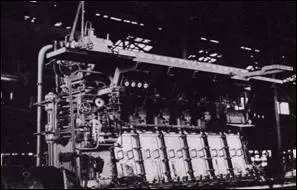
1926 Mitsui Engineering & Shipbuilding Co. Ltd. (MES), a division of Japanese shipbuilder Mitsui & Co., enters a technical licensing agreement with Burmeister & Wain on August 13th. The company builds its first MAN B&W engine in 1928, a four-stroke, single-acting, trunk type 6125M unit. In late March 2008 - 81 years later - the partnership celebrates a milestones; 60 million of B&W MAN licensed BHP (horsepower) are delivered to clients byMES.
1926 Daimler and Benz merge. The corporate name remained Daimler-Benz until the brief merger with Chrysler formed DaimlerChrysler in 1998, dissolved in 2007. However, from the turn of the century Daimler cars in Germany were called Mercedes, not Daimler (although Daimler patent licensees used Daimler as automobile brand name in Austria and England); upon merger with Benz, which built cars under the Benzname, the cars that the new Daimler-Benz firm produced became Mercedes-Benz - the brand emblem, a three-pointed star surrounded by a wreath - merged Mercedes and Benz brand symbols. They introduce the new 5K3 model which includes the new,Robert Bosch designed, glow plugs.
1927 Continuing on Fritz Lang’s injection system, Robert Bosch simplifies and improves the fuel injection system for it’s debut in the Mercedes Benz OM5 truck. By now most of the world’s freight moves by Diesel powered truck.
1929 In Indianapolis, Clessie Cummins manages to fit his 6.25 litres Diesel engine into a 1925 Packard, seven passenger car. He drives it to New York for the Auto Show where he gets the "cold shoulder" officially - but Ford and GM executives ask for private demonstration.
1929 Kawasaki and Mitsubishi of Japan sign licensing agreements with M.A.N. Kawasaki later signs agreements with Mitsui.
1929 General Motor buys the Adam Opel AG Company, in the 1930s, the largest car producer in Europe.
1930 General Motors Corporation buys the Electro-Motive Company and the Winton Engine Company. The result is Electro Motive Division (EMD) and a new aggressive campaign to slay the "fiery dragon of railroading" - the steam locomotive. They build the GM #103, a four unit, 59 meter long behemoth, painted in "grimy black" with a yellow stripe and "GM" stylized on the front. Sixteen driving axles deliver to the rails 4000 kW of power. They also support the 408,000 kg, the heaviest locomotive ever.
1931 Clessie Cummins installs his Diesel in a race car. It runs at 162 km/h in Daytona, and 138 km/h in Indianapolis where it places 12th.
1931 Winton is the first diesel engine to use a unit fuel injection system. Designed byC.D. Salisbury, the system does away with separate fuel pump and injector, and its connecting pipe work.
1931 Caterpillar introduces the 1C1 Diesel engine crawler tractor. Although more expensive than its rivals, they sell about 10,000 units, 90% of these having Diesel engines. The Cleveland Tractor Company and International Harvester follow the example shortly after.
1932 In Manchester England, L Gardner & Sons’ Hugh and Joseph Gardner, inspired by Mr. Cummins, install a Gardner 4LW Diesel in a 1925 Bentley Saloon. With a top speed of 128 km/h, they enter the car in the 1933 Monte Carlo Rally. They are encouraged to build a new lightweight engine, although the new idea was not readily accepted.
1932 CL Cummins installs a Diesel engine in a Mack 10 tonne bus. They proceed to drive across the US, 5181 km, in 78 hours 10 minutes. Faster than any other form of transport - train and such, and all for $21.80 in fuel cost.
1932 The Flying Hamburger garnishes newsreel and tabloid attention because of its radical design and performance. The Zeppelin Aircraft Works used wind tunnel testing to determine the styling of the Flying Hamburger. While the two 300 kW Maybach V12 engines, propelled the train to 198.5 km/h, it’s regular service speed was around 160 km/h.
1933 Unlike Cummins and Gardner, Daimler-Benz built cars as opposed to converting existing one to Diesel power. They took the risk and introduced the 'Manheim', powered by a noisy version of their truck engine. It is not well
received at the 1934 Berlin Auto Show. Undaunted, they redesign the idea and introduce the 260D. With it's combination of medium size sedan look and excellent fuel economy, it becomes a commercial success.
1933 Atlas-Imperial Diesel Engine Company of California introduces a fuel injection system, utilizing a common rail principal and an electromagnetic fuel injection nozzle valve, designed by Harry E. Kennedy The idea was first proposed by fellow AmericanThomas T. Gaff in 1913.
1934 M.A.N. Begins development on their exhaust gas turbine.
1934 Arthur Fielden is granted a U.S. patent for a unit fuel injector design. It is adopted by General Motors for use in their two-cycle diesel engine.
1934 May 26, the Pioneer Zephyr, modeled after the Flying Hamburger, breaks all speed and distance records on it’s run between Denver, Co. and Chicago, Il. The all stainless steel train averages 125 km/h over the 1633 km journey.
1935 B&W builds the first four stroke engine to burn Heavy Fuel Oil.
1938 General Motors forms a new division - Detroit Diesel Engine Division, they mostly build the popular inline 71 Series, a high speed two stroke engine, from a one to six cylinder configuration.
1938 Wartsila signs a licence agreement to build diesel engines with Friedrich Krupp Germania Werft AG, in Germany.
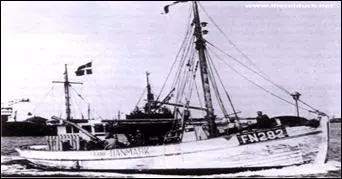
1942 The natural gas powered Danish fishing boat, 'Frank FN282'is launched. The vessel is equipped with a 2-cylinder, 90/100hp, Alpha Diesel type 342 engine, customised for 'dual fuel' operation, with oil injection as the pilot fuel igniting the gas charge.
1942 Wartsila's first diesel engine comes out of the Turku factory in November.
1939 Dodge Division of Chrysler Corporation becomes the first U.S. vehicle producer to design and build its own Diesel trucks with engines of its own design and manufacture.
1950 M.A.N. unveils the first four stroke supercharged engine to reach 45% efficiency.
1950 Prosper L'Orange son, Rudolph L'Orange's company, Gebroder L'Orange Motor Zubehor GmbH, is granted a patent for the unit injector. The patent is a result of work performed with the assistance of Karl Maybach, started in 1944. The unit injector is capable of injecting fuel at 1000 bar, up to 2000 times per minute.
1954 Cummins unveils PT (pressure-time) fuel injection system.
1957 GM Diesel Engine Division introduces the 53 Series of two strokes engines. They also begin to offer the popular 71 Series engine in V configurations. The series number refers to the swept volume of the cylinder 71 cubic inch, 53 cubic inch.
1958 The Peugeot 403 is introduced. The four cylinder Diesel powered car revives the car maker, battered from the second world war. The engine uses the licensed Ricardo Swirl chamber design. In April 1970, the Lille Peugeot Plant builds its millionth Diesel engine.

1957 The large icebreaker 'Lenin' (pictured right) is launched in the Soviet Union; first civilian ship to use nuclear propulsion. The original power plant, consisted of three OK-150 reactors, delivering 90 megawatts of power each. In 1970, the original reactors are replaced, due to to physical damage to the reactor from refuelling work, with two OK-900 reactors putting out 171 MW each. Steam generated by the reactors produced electricity in four turbo generators, driving three propellers.
1959 Not to be outdone by the Soviets, the United States, under the Eisenhower's Atoms for Peace program, launches the first "commercial" nuclear powered cargo ship.'NS Savannah' is a beautiful ship, and powered by a Babcock & Wilcox nuclear reactor, producing 74 mw of thermal power. The single propeller driven by two steam turbine, produced 20,300 shaft horsepower, to propel the nearly 600 feet, 13,599 grt ship at a top speed of 24 knots. Built at a cost of $80 Million USD, she had accommodations for 60 passengers, and cargo room for 14,040 tons, and could sail at 20 knots for 300,000 km without refuelling.
1965 GM Diesel Engine Division changes its name to the Detroit Diesel Engine Division and introduces the 149 Series of two strokes engines.
1966 Wartsila's Turku Shipyard is officially born.
1968 The first resilient mounts are used in engine installations by B&W.
1966 EMD introduced the 645 engine. V8, V12, V16, even a V20; Turbocharged or not, Power ratings were 1,500 HP V-12 non-turbocharged, 1,500 HP V-8 turbocharged, 2,300 HP V-12 turbocharged, 2,000 HP V-16 non-turbocharged, and 3,000 HP V-16 turbocharged. EMD also built a turbocharged V-20 that produced 3,600 HP for the SD-45 that was their first twenty cylinder engine. The final variant of the sixteen cylinder 645 (the 16-645F) produced 3,500 HP. EMD engines were adopted from the rail industry, and fitted into many workboats and tugs in North America.
1967 The first merchant ship to be powered by an aircraft type gas turbine, the' Admiral William M Callaghan', is launch by Sun Shipbuilding in the United States. The US military sealift ship is powered by two LM2500 gas turbines, which propelled the 24,500 ton ship to more than 21 knots.
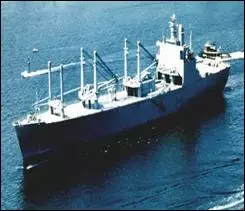
1970 Detroit Diesel merges with transmission and gas turbine maker, Allison, to form the Detroit Diesel Allison Division.
1970 The U.S. government passed the Clean Air Act.
1972 Opel introduces the Opel GT
coupe. It is the company’s first Diesel powered
car. They install a small turbocharger to their new 2 litre engine; it develops
70 kW. On June 1 and 2, the Opel GT breaks 18 international speed
records with it’s top speed of 197.5 km/h.
1972 Burmeister & Wain launched the new "Selandia"for the same customer as the original "Selandia". It serves to illustrate the dramatic pace of ship and engine development. The new Selandia is two and a half times longer, twice as wide, at 50 km/h, is two and half times faster. It’s three Diesel turbocharged, two stroke engine produced a total of 55,200 kW.
1973 The Brown, Boveri and Company introduce the supercharger, known as the Comprex AWS. A mechanically driven air pump, based on a German patent developed under the supervision of Professor Max Berchtold at the Swiss Federal Institute of Technology in Zurich.
1973 The oil crisis begins when OPEC reduces supplies of crude creating a price spike.
1974 Wartsila lays the foundation for a new shipyard in Perno, Turku.
1974 Detroit Diesel Allison Division introduces the 92 Series of high speed, two stroke engines.
1975 Mercedes introduces the 300D. The in-line five cylinder Diesel engine was radical for it’s time. The 3005 cc developed 59 kW at 4000 rpm, and it boast an overhead chain driven camshaft. The Bosch fuel pump delivered fuel to a Prosper L’Orange styled combustion chamber and started and stopped with the turn of a key.
1976 Volkswagen adapts various popular technology to introduce its four cylinder Diesel engine. The four cylinder, 1471 cc, producing 37 kW at 5000 rpm is installed in their Golf. The engine is coupled to a front wheel drive assembly. Its advertising claims state it’s the quickest accelerating Diesel car.
1976 Mercedes stuns the automotive world by building the fastest car. The Diesel powered C-111 set the new speed record at 253 km/h, averaged over 24 hours. The engine is equipped with a small Garret Airesearch turbocharger to produce 147 kW at 4200 rpm from only three litres of displacement.
1977 GM’s Oldsmobile division introduce their sedan with an 89 kW, pushrod V8 Diesel engine. It is adapted from a standard gas counterparts. They soon offer the engine in the 1978 GMC and Chevrolet pick ups. With the energy crisis of the seventies, it sparks an automotive revolution, where gas engine had previously dominated. Companies which had never marketed the efficient Diesel powered cars began to do so.
1977 The ERDA’s Energy Research Center in Oklahoma backs ups research by other independent researchers, confirming the dramatic fuel savings of the efficient Diesel engine comparatively to its gas counterparts. Figures of 43%, 25%, 35% in savings are declared, as well the cleaner burning Diesel gains popularity because of its lower emissions.
1977 Murphy Diesel of Milwaukee agrees to market MWM engines.
1978 Wartsila acquires 51% of the NOHAB diesel business from Bofors in Sweden, marking the beginning of Wartsila’s international manufacturing operations. The remaining shares are acquired in 1984.
1984 M.A.N. and B&W merge to become MAN B&W Diesel A/S, Copenhagen.
1984 EMD introduces the 710 series engine, a two-stroke diesel engine with a 710 cubic inch (11.63 liter) displacement per cylinder. Since its introduction, EMD has continually upgraded the 710G diesel engine. Power output increased from 3,800 horsepower (2,800 kW) on 1984's 16-710G3A to 4300 horsepower (as of 2006) on the16-710G3C-T2. Although primarily used in locomotives, many copies of these engines can be found on North American workboats and tugs.
1984 The 'Fair Sky' is launched by French builders, for Italian cruise line Sitmar. The ship is the last passenger ship to be built as a steam ship. Her power plant consist of three boilers, and three steam turbines, producing 29,500 shp, for a top speed of 21.8 knots, while consuming 220 tons of fuel a day.
1985 MTU acquires the L'Orange company, producers of fuel injection equipment.
1985 Deutz acquires MWM

1987 The world's largest Diesel Electric propulsion plant is installed in the passenger liner Queen Elizabeth 2. The steam systems is removed and nine, four stroke MAN L58/64, super charged, nine cylinder engines are installed, delivering a total of 94.5 MW. The engines drive alternators producing electricity for hotel service and the two 400 tons, 44 MW propulsion motors.
1987 Series 60 engine is introduced by the Detroit Diesel Corporation. The four stroke, six cylinder engine is a marked departure from their two stroke roots, for which the company was "famous" for. The engine is used widely in replacing its two stroke predecessor in the "on road" transportation sector, primarily in North America. A survival move by the company, faced with ever increasing regulatory emission framework being introduced. They later introduce the Series 50 engine, another four stroke engine design.
1988 MAN B&W acquires the French engine maker SEMT Pielstick.
1989 Wartsila Diesel acquires French high speed diesel builder SACM. They acquires a majority holding in the Dutch company Stork Werkspoor, which produces medium-speed engines.
1990 Metra is born in Tohmajärvi, Finland, with the merger of Wartsila and Lohja. The Scandinavian manufacturing powerhouses spits out various parts of itself, and others, into various popular brands such as Nokia, SKF, to name a few.
1998 EMD builds its first line of four stroke engine, the 265. Unlike its relatives, the 265 is named after the cylinder bore size, rather then the cylinder displacement (567,645, 710). The twin turbo, four stroke, V16 with a 265 mm (10.4 in) bore and a 300 mm (11.8 in) stroke, produces 6,300 bhp (4,700 kW) at 1000 rpm. Allowing the company to conform to tightening emissions standards.
1997 MTU's L'Orange introduces the first electronic common rail system for large bore diesel engines. The system later goes into mass production in 2001.
1997 Metra Corporation, Fincantieri Metra and Fincantieri agree on the merger of Wartsila Diesel, New Sulzer Diesel and Diesel Ricerche. The new company is called Wartsila NSD Corporation. The merger also includes a 40% share of Grandi Motori Trieste SpA, of which Fincantieri owns another part.
1998 P&O Nedlloyd accept delivery of the 6,674 teu container ship P&O Nedlloyd Southampton. The first ship to be powered by the 12 cylinder Sulzer RTA96C with an output of 65,880 kW.
1999 Wartsila NSD acquires the remaining shares of both Grandi Motori Trieste SpA and Stork Werkspoor.
1999 Not to be outdone, the B&W 12K98MC-C with an output of 68,640 kW is sold by the Dutch engine maker.
1999 Martin Leduc creates Martin's Marine Engineering Page, a website dedicated to the prime mover and it's application in ships and the marine world.
2000 MAN B&W acquires ALSTOM's Diesel engine business consisting of the long established Mirrlees Blackstone, Ruston and Paxman brands.
2000 Metra acquires the remaining shares of Wartsila NSD Corporation from Fincantieri, and later in September, changes its official name to simply, Wartsila. This culminate a major trend of the previous decade which saw the consolidation of many "marquee" engine brands into two dominate powerhouses, Wartsila. and MAN B&W
2000 Daimlerchrysler AG purchases Detroit Diesel Corporation, merging it with their MTU Friedrichshafen and Mercedes-Benz industrial engines businesses, creating the DaimlerChrysler Powersystems Division.
2001 nearly 36% of newly registered cars in Western Europe had diesel engines. By way of comparison: in 1996, diesel-powered cars made up only 15% of the new car registrations in Germany. Austria leads the league table of registrations of diesel-powered cars with 66%, followed by Belgium with 63% and Luxembourg with 58%.
2002 Wartsila acquires marine propulsion systems supplier, John Crane Lips. They will later move the Dutch manufacturing operations (LIPS) to china in 2010.
2003 MAN B&W introduces the ME engine. The slow speed two stroke engine does away with the traditional camshaft, replacing it with electronically controlled actuators.
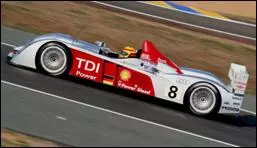
2004 Wartsila announces the forthcoming end of engine production in Turku, Finland; the bulk of the operation is moved to Italy, in 2006.
2004 Wartsila introduces their new dual fuel engine, diesel - gas, the Wartsila 46F.
2005 Wartsila acquires Deutz. Wartsila continues to voraciously gobble up numerous "minor" companies, producing a myriad of ship systems and services.
2006 June, AUDI R10 race car wins the 24hrs LeMans (France) endurance race. The R10is powered by a V12, 5.5l twin turbo, Diesel engine with common rail injection (1600bars) which develops 485kW.
2006 February, the first diesel engine with more than 100,000 bhp goes into service on February 22. MAN B&W Diesel licensee Hyundai Heavy
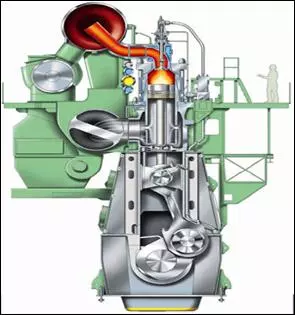
Industries in Korea built the12K98MC engine (pictured) with 101,640 bhp (75,793 kW) output. The engines are installed in series of 9,000 teu container ships for Greece
based Costamare.
2006 Tognum acquires MTU
2006 August, AP Moller Maersk Group launches the MV Emma Maersk from their Danish "Odense Steel Shipyard" at Munkebo, by far the world's largest container ship; the first in a series of eight 11,000 TEU ships (officially - 14,500 teu est). It is powered by a 14 cylinder Wärtsilä-Sulzer RTA96-C flex type Diesel engine developing just over 80 MW of propulsion power.
2007 The Dieselmax of British construction machine manufacturer JCB, achieves a top speed of 563 kilometres per hour at the Bonneville Salt Flats in the US, making it the fastest Diesel vehicle in the world, breaking the 1973 record. The Dieselmax is powered by two 4.4 litre JCB Diesel engines producing a total power of 1,119 kW.
2008 March - The German City of Augsburg celebrates Rudolph Diesel's 150th birthday on March 18, with an extensive series of events.
2009 The European Union approves the HERCULES-Beta Project; with Wartsila and MAN Diesel leading the project. It is a major international cooperative effort to maximise fuel efficiency, combined with ultra-low emissions, and to develop future generations of optimally efficient and clean marine diesel engines.
2010 Caterpillar acquires EMD (Electro Motive Division)
2010 Caterpillar acquires Germany's MWM (Motoren-Werke Mannheim) from 3i a private equity management company, who had bought the company from Deutz in 2007. Cat rolls the acquisition into its electrical power division, as MWM principally produces multi fuel, cogeneration diesel engines based plants.
2011 January - Long time MAN licensee, Hitachi Zosen, test the first large two stroke diesel engine to be fully compliant to the IMO's Tier III - a strict set of environmental emission regulations. The engine, built at the Ariake Works, in Southern Japan, is a MAN B&W 6S46MC-C8 type with an output of 7 megawatts, and boast an 80% reduction in NOx gases, using a SCR (Selective Catalytic Reduction) and EGR (Exhaust Gas Recirculation) systems.